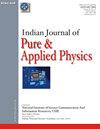用LED荧光计分析印度哈里亚纳邦Jhajjar地区地下水中的天然铀
IF 1.1
4区 物理与天体物理
Q4 PHYSICS, MULTIDISCIPLINARY
引用次数: 0
摘要
自地球诞生以来,自然放射性一直是环境的一部分。铀及其副产品等自然元素如果在地下水中过量存在,可能会造成健康问题。铀是非常有害的,因为它是剧毒的。本研究给出了从印度哈里亚纳邦Jhajjar地区多个地点的不同水源(如手摇泵和不同深度的管井)收集的40个地下水样本中铀浓度的信息。采用LED荧光法测定铀浓度。铀浓度的观测值为5 ~ 91 μgL-1,平均值为28.49 μgL-1。铀浓度的平均值低于世界卫生组织(WHO)和印度原子能管理委员会(AERB)建议的安全限值。一些地区的铀浓度很高,是因为附近的工业、农业化肥的使用增加以及该地区当地的地下地质情况。计算出的终身癌症发病率和死亡率的危险因素并不重要,因为它们远低于允许的危险限度。铀的化学毒性以LADD(终生平均日剂量)的形式测量,其值为0.39 ~ 6.67 μg kg - l - 1天,平均值为2.02 μg - l - 1天,超过了世界卫生组织推荐的LADD日消费阈值1.0 μg - l - 1天。年有效剂量范围为0.89 ~ 15.16 μSv/Y,平均值为4.74 μSv/Y,低于世界卫生组织规定的100 μSv/Y的安全限值。本文章由计算机程序翻译,如有差异,请以英文原文为准。
Analysis of Natural Uranium in Groundwater of Jhajjar District of Haryana, India using LED Fluorimeter
Natural radioactivity has been a part of the environment since the creation of earth. Natural elements like uranium and its by-products can be reason of health problems if they are present in groundwater at excessive amount. Uranium is very harmful because it is very toxic. This study gives the information about the uranium concentration in 40 groundwater samples collected from different water sources like hand pump and tube wells of different depths from numerous locations of Jhajjar district of Haryana, India. Uranium concentration was measured using the LED fluorimetry technique. The observed value of uranium concentration ranged from 5 μgL-1 to 91 μgL-1 with mean value of 28.49 μgL-1. The mean value of uranium concentration is below the safe limit suggested by World Health Organisation (WHO) and Atomic Energy Regulatory Board (AERB), India. The uranium concentration in some region is high because of nearby industries, increasing uses of fertilizer for agriculture and the local subsurface geology of the region. The calculated risk factors for lifelong cancer morbidity and mortality are not significant because they are much lower than the permitted hazard limits. The chemical toxicity of uranium is measured in form of LADD (Lifetime Average Daily Dose) value was ranging from 0.39 to 6.67 μg kgˉ¹ dayˉ¹ with mean value of 2.02 μg kgˉ¹ dayˉ¹g which is more than the WHO recommended daily consumption threshold of LADD of 1.0 μg kgˉ¹ dayˉ¹. Values of annual effective dose is varying from 0.89-15.16 μSv/Y with mean value is 4.74 μSv/Y, which is below the safe limit of 100 μSv/y (WHO).
求助全文
通过发布文献求助,成功后即可免费获取论文全文。
去求助
来源期刊
CiteScore
1.30
自引率
14.30%
发文量
42
审稿时长
7 months
期刊介绍:
Started in 1963, this journal publishes Original Research Contribution as full papers, notes and reviews on classical and quantum physics, relativity and gravitation; statistical physics and thermodynamics; specific instrumentation and techniques of general use in physics, elementary particles and fields, nuclear physics, atomic and molecular physics, fundamental area of phenomenology, optics, acoustics and fluid dynamics, plasmas and electric discharges, condensed matter-structural, mechanical and thermal properties, electronic, structure, electrical, magnetic and optical properties, cross-disciplinary physics and related areas of science and technology, geophysics, astrophysics and astronomy. It also includes latest findings in the subject under News Scan.

 求助内容:
求助内容: 应助结果提醒方式:
应助结果提醒方式:


